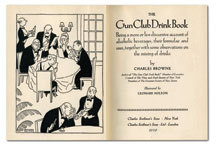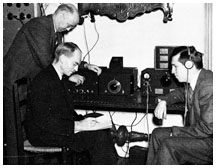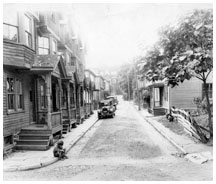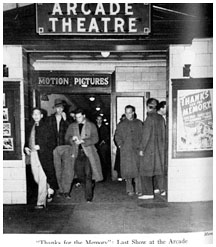
|
October 24, 2007: Features
Former Princeton mayor Charles Browne 1896, described in Time magazine as “Princeton’s most popular citizen,” published this book in 1939 “to teach people to drink again” after the repeal of Prohibition. For two recipes, click here.
Scrip provided by the Prince and signed by business manager William Selden ’34 for use at local shops during the “bank holiday” of 1933. The scrip was to be redeemed when banks reopened.
From left, Brunson S. McCutchen ’15, Professor John B. Whitton, and Harold N. Graves ’35 listen to short-wave radio broadcasts at the Princeton Listening Center on Alexander Street. The center monitored wartime reports from Great Britain, France, Germany, and Italy.
A view from the late 1920s or early 1930s of Baker's Alley, in a largely black community, before construction of Palmer Square. The development soon would displace many residents. Baker Alley homes were moved on logs to Birch Avenue.
Students leaving the final show at the Arcade Theatre on Nassau Street, one of Princeton’s two movie houses. The last movie was – appropriately enough – “Thanks for the Memory.” PAW reported in January 1939: “At the farewell performance, undergraduates strove to excel themselves in final wisecracks.” |
Going back to the ’30s
“Princeton has furnished its full quota to the army of the unemployed,”
began the 1931 report of the local Community League, a civic group. That’s
one view of the town during the Depression years, which come to life —
through photographs, documents, and artifacts, including what’s
said to be Albert Einstein’s favorite chair — in an exhibition
at the Historical Society of Princeton. While life at the University continued
pretty much as usual (though a newspaper article on display notes the
increased demand for financial aid), the years were harsher for townsfolk.
The Community League mounted relief drives to help feed and clothe the
needy, and Italian immigrants who had come to build Princeton’s
collegiate gothic campus found themselves out of work when construction
wound down. The beginning of the decade saw the founding of the Institute
for Advanced Study; the end, the creation of Palmer Square, which displaced
many poor and minority residents. And after the Depression years led into
the war years, changes would come even more furiously, with school desegregation,
massive growth at the University, and farmland giving way to development,
says Eileen Morales, the exhibition curator. “The 1930s in Princeton,”
she says, “were in many ways the end of an era in the town’s
history.” ![]()
“Princeton in the 1930s” runs through July 13, 2008, at Bainbridge House, 158 Nassau St., in Princeton. Admission is free. For more information, call (609) 921-6748 or visit www.princetonhistory.org.
Photos courtesy Historical Society of Princeton .





